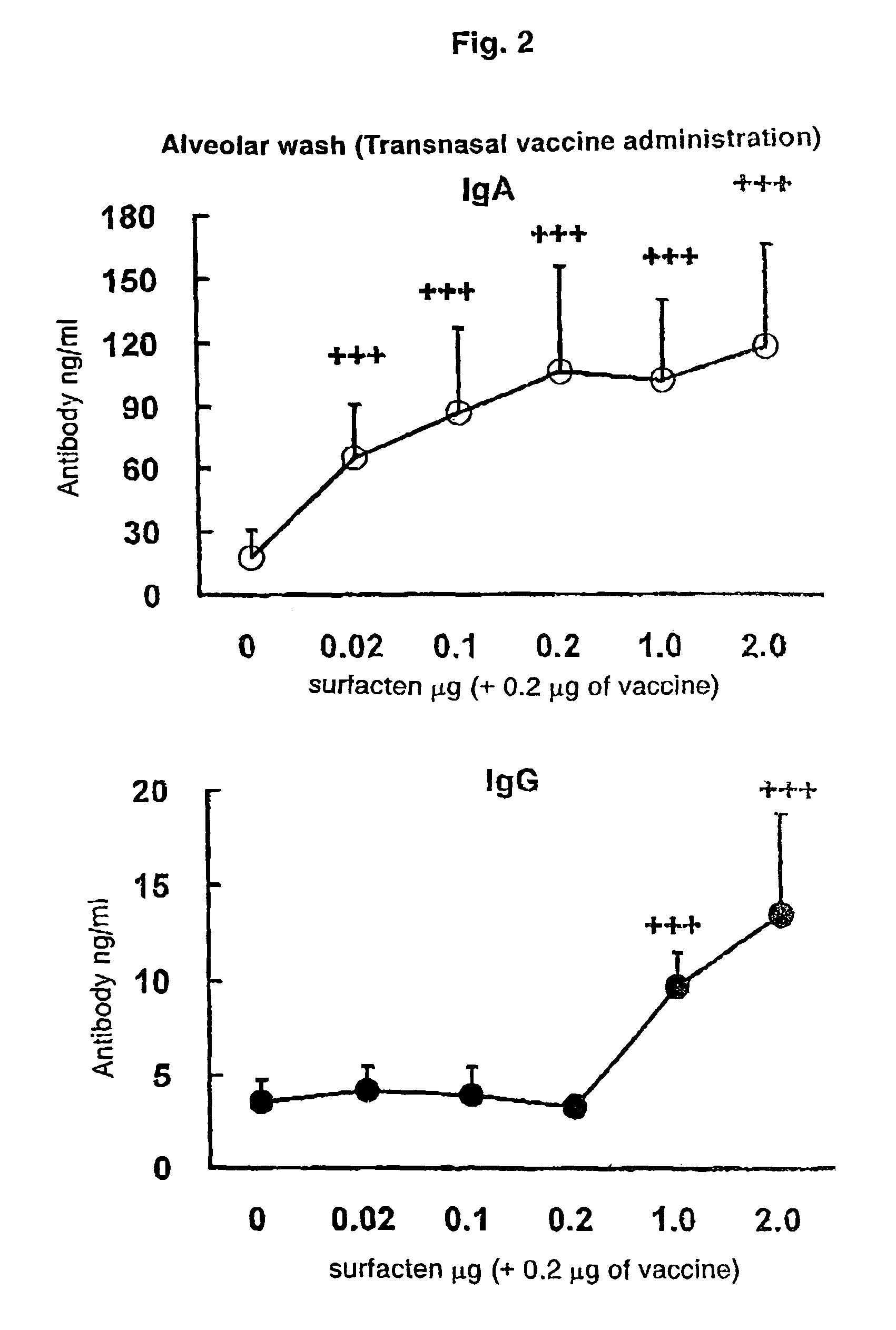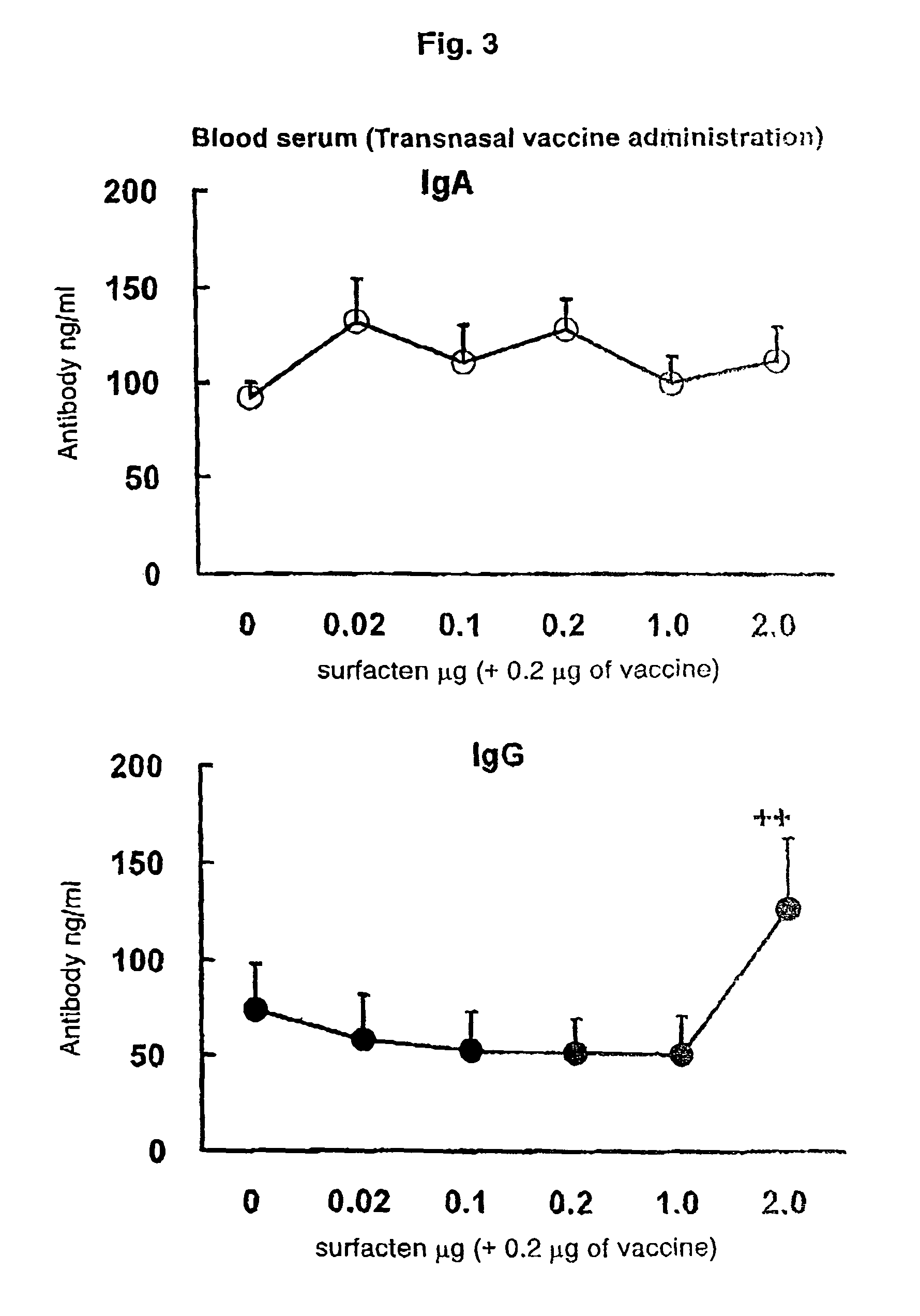Mucosal vaccine enabling switching from production of IgA antibody to production of both of IgA and IgG antibodies
a mucosal vaccine and iga technology, applied in the field of antigen-based vehicles, to achieve the effects of improving medical practice/healthcare/hygiene, excellent infection prevention effect, and promoting prophylactic/therapeutic effects
- Summary
- Abstract
- Description
- Claims
- Application Information
AI Technical Summary
Benefits of technology
Problems solved by technology
Method used
Image
Examples
reference example 1
AD Vehicle Preparations and Samples
[0107]Preparations and samples of pulmonary surfactants to be used as AD vehicles in this invention will be hereinafter described. Sample prepared from a cow lung by the method of Howood, et al. (Biochemistry, 24, 184-190, 1985); a sample obtained by eliminating water-soluble protein components SP-A and SD-D through extraction with 1-butanol from the sample or reducing SP-A and SD-D to an amount lower than the detection limit in the sample (Haasman H. P., et al, J. Biol. Chem., 262, 13977-13880, 1987); sample containing 2 or more of lipids selected from 40 wt % or more of phospholipids such as phosphatidylcholine and dipalmitoylphosphatidylcholine, about 10 to 30 wt % of phosphatidylglycerol, about 2 to about 5 wt % of phosphatidylserine, about 1.0 to about 20 wt % of palmitic acid, and the like, a pulmonary surfactant-derived liposoluble (hydrophobic) protein, an active region of SP-B and / or SP-C or a synthetic peptide containing the active region...
experimental example 1
Preparation of Split Influenza Vaccine
[0108]By using an embryonated egg-derived suspension [1×108 PFU (Plaque Forming Unit)] inoculated with an influenza-A virus strain Aichi / 68 / 2 / H3N2 (offered from Dr. Masanobu Ohuchi of Department of Microbiology of Kawasaki Medical School), a split influenza vaccine was prepared by the following operation. To the virus suspension dialyzed overnight with 0.004 M PBS [product of Takara Bio Inc. (Japan)], 0.05 vol % of β-propiolactone [product of Wako Pure Chemical Industries, Ltd. (Japan)] was added to achieve a final concentration of 8 nM, followed by virus inactivation by incubation in an ice bath for 18 hours. Subsequently, β-propiolactone was subjected to hydrolytic degradation by incubation at 37° C. for 1.5 hours. After completion of the hydrolytic degradation, Tween 80 [product of Wako Pure Chemical Industries, Ltd. (Japan)] was added to achieve a final concentration of 0.1 wt %, and diethylether [product of Wako Pure Chemical Industries, Lt...
experimental example 2
Preparation of Transnasal / Mucosal Vaccine
[0109]The split influenza vaccine stock solution obtained by Experimental Example 1 and the AD vehicle described in Reference Example 1 were mixed. After suspending the AD vehicle into PBS (phosphate buffer saline) until a concentration required for vaccination is achieved, a supersonic wave treatment was performed at a room temperature for 5 minutes to obtain a uniform suspension. To the suspension, 0.1 μg (dry weight) of the vaccine stock solution was added with respect to 0.1 μg (dry weight) of the AD vehicle, followed by mixing with Vortex Mixer, and the mixture was left to stand at a room temperature for one hour to prepare a transnasal / mucosal vaccine for IgA induction. Also, after adding 0.1 μg (dry weight) of the vaccine stock solution with respect to 1.0 μg (dry weight) of the AD vehicle, a transnasal / mucosal vaccine for both of IgA and IgG induction was prepared in the same manner as described above.
PUM
| Property | Measurement | Unit |
|---|---|---|
| temperature | aaaaa | aaaaa |
| temperature | aaaaa | aaaaa |
| dry weight | aaaaa | aaaaa |
Abstract
Description
Claims
Application Information
 Login to View More
Login to View More - R&D
- Intellectual Property
- Life Sciences
- Materials
- Tech Scout
- Unparalleled Data Quality
- Higher Quality Content
- 60% Fewer Hallucinations
Browse by: Latest US Patents, China's latest patents, Technical Efficacy Thesaurus, Application Domain, Technology Topic, Popular Technical Reports.
© 2025 PatSnap. All rights reserved.Legal|Privacy policy|Modern Slavery Act Transparency Statement|Sitemap|About US| Contact US: help@patsnap.com



